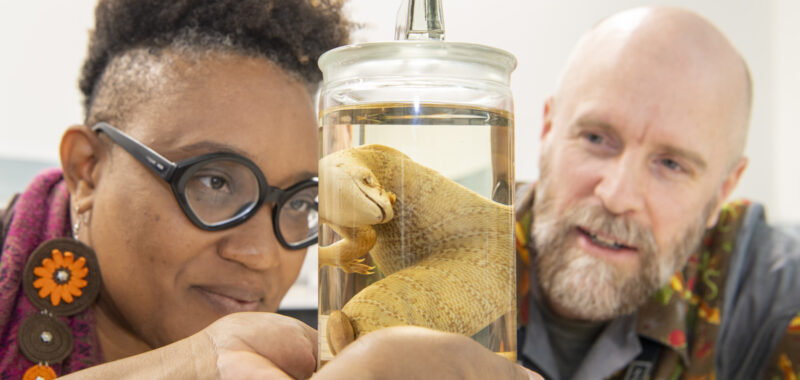A specimen of the Jamaican giant galliwasp, thought to be female and therefore named Celeste after its genus (Celestus), has been returned to the Natural History Museum of Jamaica (NHMJ) in one of the first such repatriations to the Caribbean. Celeste’s long-awaited homecoming, an important step toward reparations for colonial harms and injustices, has triggered wider debates around the repatriation of cultural and natural heritage and ancestral remains in the region.
Long held at the University of Glasgow, Celeste was deposited in the National Reptile Collections at the NHMJ on permanent loan and is currently on display at Jamaica’s Houses of Parliament for the sectoral debate taking place throughout June, which included a renewed commitment by Jamaica’s Minister of Culture, Gender, Entertainment and Sport Olivia Grange to pursue the repatriation of Jamaica’s cultural and natural heritage. Plans for a permanent display for Celeste are underway, as the majority of Jamaica’s public has never seen a specimen of this species.
The Jamaican giant galliwasp was last recorded in the mid-1800s, before the lizard became extinct as a result of loss of habitat due to industrial agriculture and the booming colonial sugar cane industry. Rats arrived on board colonial ships and rapidly became a pest around Jamaica. Plantation owners subsequently introduced the small Indian mongoose to get rid of the rats; however, many endemic wildlife species also fell prey to the mongooses, including the Jamaican giant galliwasp (although other smaller endemic galliwasp species can still be found in Jamaica today). Many see its fate as yet another reminder of the far-reaching and disastrous consequences of colonialism.
“The repatriation of this specimen is transformational to how we conduct research, how we develop knowledge, and also just in terms of providing scholars with access to what the specimen looks like,” Shani Roper, a curator at the University of the West Indies (UWI) Museum, said in a statement.

The repatriation was made possible by a Memorandum of Understanding between the University of Glasgow and UWI aimed at fostering collaboration in research and education and rectifying colonial injustices.
Scientists from the NHMJ and UWI traveled to Glasgow in April 2024 to pick up the reptile specimen, which was repatriated by the University of Glasgow under the 2019 memorandum. Originally a part of the Andersonian collection, it was absorbed into the school’s Hunterian Museum collections in 1888 but had remained in storage. Scientists in Jamaica could study the Jamaican giant galliwasp only if they were traveling to the United Kingdom or the United States, where they could engage with specimens in collections there or study an (inaccurate) drawing by Hans Sloane, a collector of natural history who traveled to Jamaica in the 1680s.
The repatriation of the lizard — and its subsequent public display — is therefore seen as an important step towards epistemic justice.
Although the Jamaican giant galliwasp has been extinct for many years, folklore kept the image of the lizard alive. The travel company Expedia UK was so taken by the idea of the Jamaican giant galliwasp that it used its image for a 2016 campaign of vintage travel posters. “We … realised that a lot of people don’t know about the animals once endemic to particular countries — yet this information forms an important part of a country’s heritage,” a spokesperson for the company stated at the time.


Folklore plays an important role in a country’s natural and cultural heritage preservation and protection, and in Jamaica, much of it relates to the environment. According to Jamaican folklore, if a galliwasp (also called a gallawass or galawasp) bites you, you must run to the closest body of water, but if it arrives there before you, there is a risk of death. As there was no further opportunity to interact with or study the giant galliwasp, this misunderstanding endured. Tangible and intangible heritage — whether natural or cultural — are therefore essential in knowledge production, and their removal can have far-reaching consequences for a community’s identity, sense of belonging, and knowledge base.
The return of Celeste will hopefully establish a new teaching and research agenda, but also foster further national understanding of the significance of the Jamaican giant galliwasp to Jamaican culture and society. Celeste is not the first object to be repatriated to Jamaica: The Natural History Museum in London returned the Anthony Robinson Volumes to the Institute of Jamaica in 2009 and the University of London’s Royal Holloway College donated aerial photographs of the West Indian British colonies to UWI in 2016.
In addition, Grange requested the return of Taíno objects from the British Museum in 2019, including a statue of “Boinayel the Rain Giver,” whose tears are believed to create rain. Like Celeste, this statue is also not on display in the UK and remains far removed from its community of origin.
Celeste’s homecoming symbolizes the many different facets of colonial plunder and its far-reaching consequences for cultural beliefs and knowledge production, and is hoped to serve as a first step towards broader conversations around repatriation, and ultimately, justice for colonial harms, violence, and exploitation. Since the return is taking place between two private institutions, it also presents the opportunity for Caribbean museums to set up a framework for future repatriations of cultural and natural heritage. As Roper explained: “If you can return a lizard, then you absolutely can return anything.”

